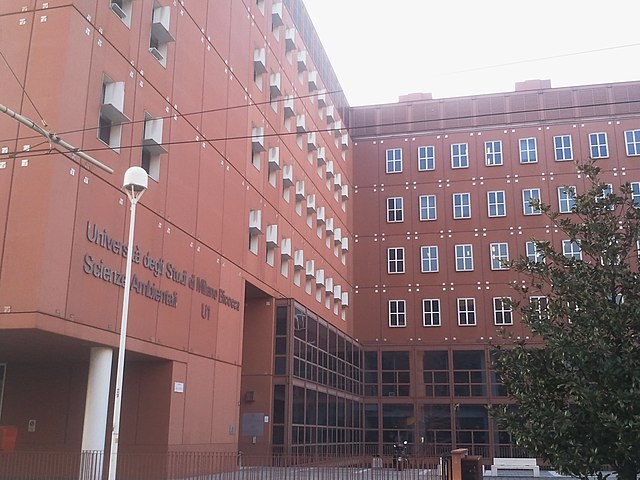Top Qs
Timeline
Chat
Perspective
University of Milano-Bicocca
Public university in Milan, Italy From Wikipedia, the free encyclopedia
Remove ads
The University of Milano-Bicocca (Italian: Università degli Studi di Milano-Bicocca, UNIMIB) is a public university located in Milan, Italy, providing undergraduate, graduate and post-graduate education. Established in 1998, it was ranked by the Times Higher Education 2014 ranking of the best 100 Universities under 50 years old as number 21 worldwide and first in Italy.
Remove ads
Campus
The University of Milano-Bicocca is located in an area on the northern outskirts of Milan, which was occupied by the Pirelli industrial complex until the late 1980s. The industrial area has been redesigned by architect Vittorio Gregotti into an urban complex, including the University of Milano-Bicocca's research laboratories and student residence halls.[1]
Medical schools
The Italian language course of the Faculty of Medicine of the University of Milano-Bicocca is held in Monza.[2]
The English language medical course is held at the Pope John XXIII Hospital in Bergamo.[3]
Remove ads
History
The University of Milano-Bicocca has its origins from the splitting of the University of Milan, which with about 90,000 students in the 1990s was becoming overcrowded. A large area in the north of Milan, the Bicocca, was chosen as the location for the new university. This area was occupied by the Pirelli industrial complex until the 1980s and the new campus was part of a larger urban renewal project. The university was officially established on 10 June 1998.
Milan-Bicocca is a multidisciplinary university which offers a wide range of academic programs in different disciplinary fields: Economics, Informatics, Statistics, Law, Education, Sociology, Medicine and Surgery, Mathematics, Natural Sciences, Physics and Astrophysics, Chemistry, Computer Sciences, Biotechnology and Psychology.
Remove ads
Organization

There are fourteen Departments and two Schools at the University of Milan-Bicocca:
- Department of Economics Management and Statistics[4]
- Department of Business and Law[5]
- Department of Statistics and Quantitative Methods[6]
- Department of Biotechnology and Biosciences[8]
- Department of Physics[9]
- Department of Informatics, System and Communication [10]
- Department of Mathematics and its Applications [11]
- Department of Materials Science[12]
- Department of Earth and Environmental Sciences[13]
- Department of Law[15]
- Department of Medicine and Surgery[16]
- Department of Psychology[17]
- Department of Human Sciences for Education[18]
- Department of Sociology and Social Research [19]
The number of students at the university has grown steadily since it opened: in its first academic year there were 15,300 students, which had risen to 27,481 in 2003-2004 and by 2005-2006 there were over 30,000. In 2023 the number of students is almost 40.000.
Rankings
See also
References
External links
Wikiwand - on
Seamless Wikipedia browsing. On steroids.
Remove ads


